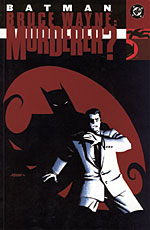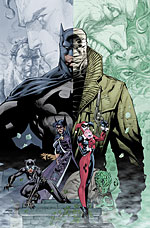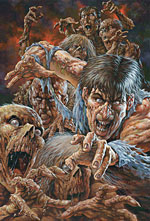>> The Book Review: The Horde
>> What About Bob? An interview with Bob Schreck, Part Two
More...

For part one of this interview, click here.
Though he's worked with many different creators on a huge number of titles at several different publishers, editor Bob Schreck is still perhaps best known for his association with one character, Batman. As group editor of the Batman titles, he oversees all the character's storylines, and he's the man who holds together the crossover events.
While crossovers are frustrating to some readers, Schreck defends them. "It's what some would call crass marketing, but most importantly for me it's banging the drum and telling everybody, 'Hey! Look over here! We're doing some interesting stuff, and we're changing this and making some bold statements'.
"In putting together something like WAR GAMES, our writers need to know where they need to go and that's what we do as editors. We ask what we want to change, what's our goal, and then we try to figure out the best possible way to achieve that goal. And then what Matt [Idelson] and I do is we get a basic idea, sit down with Michael [Wright] and Nachie [Castro], and we all talk it through, and then we run it up the pole.
"We take it to Dan DiDio and Paul Levitz in its rawest form. We try not to think it through too much, we just think of the bigger beats logically. And then once they approve it, we send it off to the writers, who know every now and then that they're going to all have to play in the same sandbox with each other, which they should, to some degree, be keeping tabs on what each other is doing so that our continuity makes some kind of sense. And for the most part they do."
"If you're working with professionals, which we always try to do, they realize that it's time for them to put my A-story on the back burner a little bit and jump in on this story. At first it appears very convoluted and complicated and difficult, but after you've done it a few times, it gets a lot easier."
Schreck isn't deaf to some readers' complaints about crossovers, but he's confident that the recent crossovers in the Batman family have paid off.
 "We were all very happy with the way BRUCE WAYNE: MURDERER, BATMAN: FUGITIVE and WAR GAMES came together. I was very pleased with them. Everybody got behind WAR GAMES and it sold very well. Fans are right, no one wants a lame stunt, they don't want to read 20 books and when you get to the end of it you're bored. Trust me, nobody wants that. Does it happen from time to time? Yes. Are we happy when it does? No. Are we happy when it works? Hot damn, and that's our intention every time. Let's do something that sounds like fun and sometimes you win and sometimes you lose. We've had a pretty good track record so far..."
"We were all very happy with the way BRUCE WAYNE: MURDERER, BATMAN: FUGITIVE and WAR GAMES came together. I was very pleased with them. Everybody got behind WAR GAMES and it sold very well. Fans are right, no one wants a lame stunt, they don't want to read 20 books and when you get to the end of it you're bored. Trust me, nobody wants that. Does it happen from time to time? Yes. Are we happy when it does? No. Are we happy when it works? Hot damn, and that's our intention every time. Let's do something that sounds like fun and sometimes you win and sometimes you lose. We've had a pretty good track record so far..."
Of course, crossovers aren't the only way to grab the audience's attention. Getting a big name creator like Jim Lee on to a book is also a big draw, though in the case of Lee, Schreck credits editor Mark Chiarello as the man who got him to sign up.
"It's a dance. You want your book to read by as many people as possible. How do you that? Doing a crossover where all the books come together every two or three years is one way of doing it. Another way is giving Jeph Loeb and Jim Lee the keys to the car and letting them go play, and everybody comes and watches the show. And where do we go from here, well that's the never-ending question. What do we do next? I dunno. Let's reinvent the wheel."
Producing a comic generally takes nine months, just like having a baby, to go from script to the stands. "Production is almost all done via e-mail and the internet these days. If it's a regular run like BATMAN or DETECTIVE, the writer will e-mail me a script and I will read it and in turn write down all my notes on the first pass.
"And then I usually call the writer and with their copy in-hand I try to work things out by asking questions like, what are you trying to say here. Or I'll just say I don't know what's wrong with this sentence, but I know it's wrong. It doesn't sound like the character it's coming from. Or, if you're trying to say this, then perhaps you can say it this way. Why don't you think about it and then incorporate it into script? And when they've gotten all my thoughts a day or two later I'll get the final version.
"And then you send out the close-to-final script to the penciler, and the penciler takes it from there and if he has any questions it's much easier to find me than to be on the phone with the writer.
 "The banter between writer and artist is usually less about the physical beats of the story that will change what I'm having to keep my eye on, and more about mood and concepts. If there are any wholehearted changes, and they're being fair, someone in the creative team will call me and let me know they're thinking of taking a scene in another direction. It's all about clear communication. Otherwise we get a book that doesn't reflect what was originally intended by the writer and DC.
"The banter between writer and artist is usually less about the physical beats of the story that will change what I'm having to keep my eye on, and more about mood and concepts. If there are any wholehearted changes, and they're being fair, someone in the creative team will call me and let me know they're thinking of taking a scene in another direction. It's all about clear communication. Otherwise we get a book that doesn't reflect what was originally intended by the writer and DC.
"The penciled art boards then go to the inker. These days the lettering is all done at the end by computer, so after it's inked it then gets either photocopied or made into computer files and sent to the colorist, and I try to connect either the artist or the inker to the colorist so they can talk and get an idea what they were thinking palate-wise. It's a lot to juggle. That's why we have four people in the group editing our line of books."
Though the Batman titles are Bob Schreck's principle responsibility, when it comes to developing non-Batman projects, his freedom is only limited by his time. Among the non-Batman products he's been most thrilled with of late is Judd Winick's mini series CAPER, a creator-owned book about crime across three generations, with artists Farel Dalrymple, John Severin and Tom Fowler.
"I don't get something like CAPER in the mail every day. I get a lot of stuff in the mail every day, but I don't read something that makes me say, 'Oh my god', right out of the gate.
"When I read the first basic premise from Judd I told him it was amazing and that he was sick, and that no one was gonna expect this from him. And yes, there's a little Coen brothers in there, and a little Elmore Leonard, a little bit of this a little of that. But CAPER is Judd's very unique creation. It's what every creator does. We look over our shoulders, we all learn from where we've come from, but we take it and bring it another step further."
One of Schreck's current big projects outside the Batman milieu is a horror anthology for mature readers, or as he describes it, lots of chunky, fleshy parts.
 "TOE TAGS is coming along swimmingly. Tommy Castillo, who's the penciler, is one of those people I was talking about earlier. When I first saw his stuff I knew this gent had the right chops for what we wanted to do. Yeah, he's very much a Bernie Wrightson fan, but Bernie had his idols before him, as well. Artists like Ghastly (Graham Ingels), Frazetta and other guys from the EC Comics days, as well as all of the great old illustrators down through history. Tommy isn't just getting his inspiration from Bernie, he has studied all of those same great artists that Bernie studied. He, like all of us, stands on the shoulders of those giants who have come before. That's how we learn.
"TOE TAGS is coming along swimmingly. Tommy Castillo, who's the penciler, is one of those people I was talking about earlier. When I first saw his stuff I knew this gent had the right chops for what we wanted to do. Yeah, he's very much a Bernie Wrightson fan, but Bernie had his idols before him, as well. Artists like Ghastly (Graham Ingels), Frazetta and other guys from the EC Comics days, as well as all of the great old illustrators down through history. Tommy isn't just getting his inspiration from Bernie, he has studied all of those same great artists that Bernie studied. He, like all of us, stands on the shoulders of those giants who have come before. That's how we learn.
"I called him the week before Christmas [2003] to ask him about penciling a George Romero story, and I swear if he could have reached through the phone and kissed me, he would have. He said, this is best Christmas present I've ever gotten, and I told him he would do it justice."
As for getting horror master George Romero on board, the legendary creator of DAWN OF THE DEAD creator was easily persuaded.
"I just asked him if he wanted to do a horror book, but explained that we didn't have a lot of money to spend, like they do in Hollywood. He replied, 'Bob hold on, it's going to be fun, right?' That's all he really cared about, are we going to have fun doing this? It was like a dream come true. I'm working with George Romero. I mean shoot me. I can't believe it. And he's a joy to work with and he's a really funny guy."
Though he's made his name in comics as an editor, Schreck admits that he's sometimes been tempted to try his hand at writing... and then he thinks better of it.
"I'm actually a much better writer for the screen than for comics. If you read my writing for comics and my writing for the screen, you'd know. I started making films when I was a kid around nine years old, and I didn't really read comics until about fourteen. I just understand the language of cinema better and I can communicate my ideas better on paper for a more fluid visual medium than comics."
But for Schreck, editing clearly remains not just a vocation, but an obsession. "You can't help but proofread. Years ago, when Diana and I would go to a restaurant, she would edit the menu and it would drive me crazy. Now I do the same thing, sitting there going, that's not how you spell scungilli! There's no 'O' in scungilli!"

This article is Ideological Freeware. The author grants permission for its reproduction and redistribution by private individuals on condition that the author and source of the article are clearly shown, no charge is made, and the whole article is reproduced intact, including this notice.


